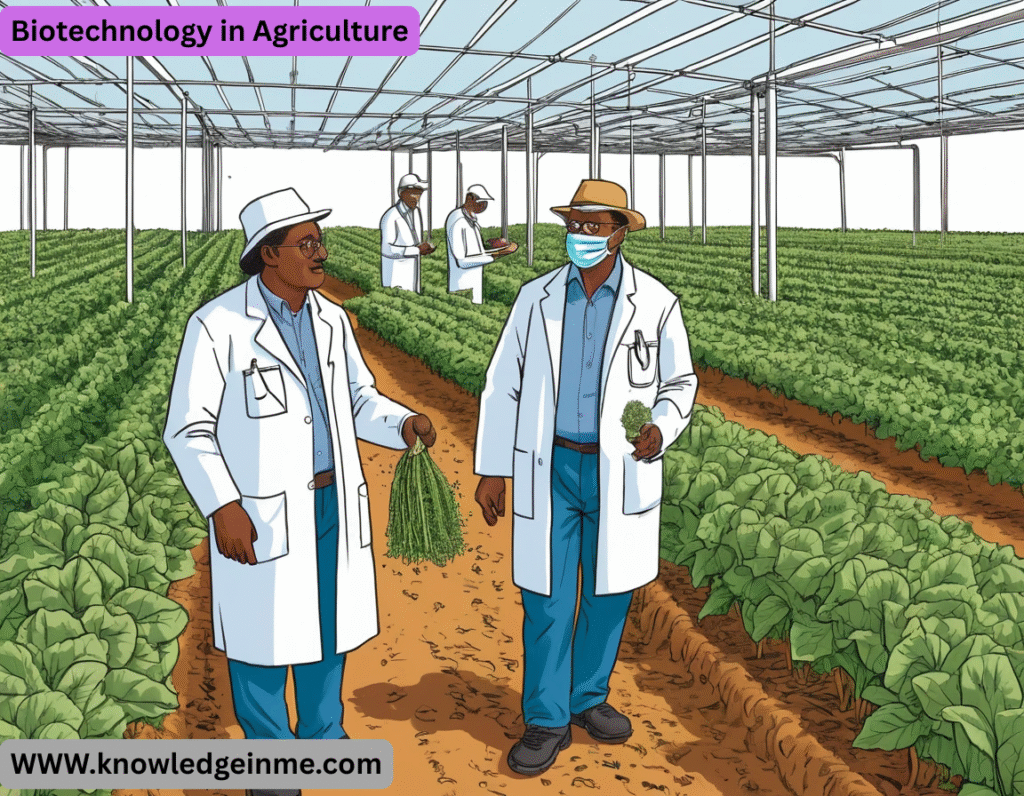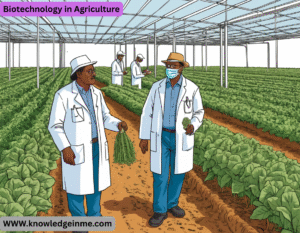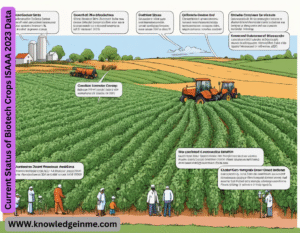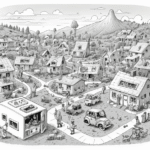Biotechnology in Agriculture Biotechnology in agriculture involves using scientific techniques, including genetic engineering, molecular markers, and tissue culture, to improve crops, livestock, and microorganisms for enhanced productivity, sustainability, and resilience. It plays a crucial role in addressing global challenges such as food security, climate change, and pest resistance.
Key Applications of Agricultural Biotechnology
Genetically Modified (GM) Crops
- Crops like BT cotton, herbicide-resistant soybeans, and Golden Rice are engineered for traits such as:
- Pest resistance (e.g., BT toxin against insects)
- Herbicide tolerance (e.g., Roundup Ready crops)
- Enhanced nutrition (e.g., Vitamin A-enriched Golden Rice)
CRISPR & Gene Editing
- Allows precise modifications in plant DNA to improve yield, drought tolerance, and disease resistance without introducing foreign genes.
- Examples: Non-browning mushrooms, mildew-resistant wheat.
- Molecular Markers & Marker-Assisted Breeding
- Speeds up traditional breeding by identifying desirable traits (e.g., disease resistance) at the DNA level.
Biofertilizers & Biopesticides
- Microbes like Rhizobium (fixes nitrogen) and Bacillus thuringiensis (natural pesticide) reduce chemical use.
- Disease-Resistant & Climate-Resilient Crops
- Development of crops resistant to viruses, fungi, and extreme weather (e.g., flood-tolerant rice).
Livestock Biotechnology
- Transgenic animals (e.g., faster-growing salmon)
- Disease-resistant breeds (e.g., PRRS virus-resistant pigs)
- Artificial insemination & cloning for improved genetics.
Synthetic Biology & Microbes
- Engineered microbes can enhance soil health or produce plant growth-promoting substances.
- Benefits of Agricultural Biotechnology
- Increased Crop Yields – More food production per acre.
- Reduced Pesticide Use – GM crops like Bt cotton lower chemical dependency.
- Enhanced Nutrition – Biofortified crops combat malnutrition.
- Climate Adaptation – Drought/flood-resistant varieties.
- Sustainable Farming – Less soil erosion, fewer chemicals.
Controversies & Challenges
- GMO Opposition – Concerns over long-term health/environmental effects.
- Corporate Control – Patents on seeds (e.g., Monsanto’s Roundup Ready).
- Biodiversity Risks – Gene flow to wild plants, superweeds.
- Regulatory Hurdles – Strict GMO laws in the EU and some countries.
Future Trends
- Gene-Edited Crops (non-GMO CRISPR varieties gaining acceptance)
- Vertical & Lab-Grown Food (cellular agriculture for meat/milk)
- Microbiome Engineering (soil and plant microbes for sustainability)
- AI & Precision Farming (biotech combined with data analytics)
Core Techniques in Agricultural Biotechnology
Genetic Engineering Transgenic Crops
- Process: Inserting foreign genes (from bacteria, viruses, or other species) into crops to confer desirable traits.
Examples:
- BT Cotton & Corn – Contains a gene from Bacillus thuringiensis to resist pests like bollworms.
- Golden Rice – Engineered with beta-carotene (Vitamin A precursor) to combat malnutrition.
- Arctic Apples – Gene silencing prevents browning when sliced.
CRISPR-Cas9 & Gene Editing
- How it works: Uses a bacterial defense system to make precise DNA cuts, enabling targeted gene modifications.
- Advantages over GMOs: No foreign DNA is inserted; edits can mimic natural mutations.
Applications:
- Non-browning mushrooms (reduced polyphenol oxidase)
- Waxy corn (high amylopectin for industrial use)
- Drought-resistant wheat (edited for deeper roots)
RNA Interference (RNAi) Technology
- Mechanism: Silences specific genes in pests or pathogens.
Example:
- RNAi Potato – Resists late blight by silencing fungal genes.
- RNAi Spray – A biodegradable spray to combat insect pests without genetic modification.
Marker-Assisted Selection MAS
- Process: Uses DNA markers to identify plants with desired traits (e.g., disease resistance) early in breeding.
Example:
- Scuba Rice – Flood-tolerant rice developed using MAS.
Synthetic Biology & Microbial Engineering
Applications:
- Nitrogen-fixing bacteria for non-legume crops (reducing fertilizer need).
- Engineered yeast producing milk proteins (for lab-made dairy).
Biotechnology in Livestock & Aquaculture
Transgenic Animals
- Fast-growing salmon (AQU Advantage) – Engineered with growth hormone genes.
- Enviropig – Modified to digest phosphorus efficiently, reducing pollution (discontinued due to public backlash).
Gene Editing in Livestock
- PRRS-resistant pigs – CRISPR-edited to block the Porcine Reproductive and Respiratory Syndrome virus.
- Hornless cattle – Edited to eliminate painful dehorning.
Cloning & Reproductive Biotech
- Somatic Cell Nuclear Transfer (SCNT) – Produces genetically identical animals (e.g., Dolly the sheep).
Environmental & Economic Impacts
A. Benefits
- Higher Yields – GM crops have increased global food production by 22% (Nature, 2014).
- Reduced Pesticides –BT crops cut insecticide use by 37% (PLOS One, 2014).
Risks & Controversies
Ecological Concerns
- Superweeds – Herbicide-resistant weeds due to overuse of glyphosate (Roundup).
- Gene Flow – Cross-pollination with wild relatives (e.g., GM canola in Canada).
Health Debates
- Allergenicity – Potential unintended effects (e.g., Brazil nut gene in soybeans, later discontinued).
- Long-term studies – Mixed findings; WHO & FDA deem approved GMOs safe, but critics demand more research.
Corporate Monopolies
- Seed Patents – Companies like Bayer-Monsanto control 90% of GM seeds, raising costs for farmers.
Regulatory & Public Perception Challenges
Global GMO Regulations
- Pro-GMO Countries:
- USA, Canada, Brazil – Lax regulations, widespread adoption.
Restrictive Countries:
- EU – Strict labeling & bans (Precautionary Principle).
- India – BT cotton allowed, but GM food crops face resistance.
Public Acceptance
- Pro-GMO Arguments: Science-backed safety, food security benefits.
- Anti-GMO Arguments: Fear of corporate control, ecological risks.
- Middle Ground? Gene-edited crops (non-transgenic) may gain wider acceptance.
Future Innovations in AGRI-Biotech
- Next-Gen CRISPR & Gene Drives
- Self-propagating edits (e.g., eradicating malaria mosquitoes) could be adapted for invasive weeds.
AI & Precision Agriculture
- Machine learning + biotech = predictive breeding, disease detection via drones.
Lab-Grown Meat & Cellular Agriculture
- Cultured meat (e.g., Memphis Meats) reduces livestock environmental impact.
- Foundations of Agricultural Biotechnology
The Science Behind GMOs & Gene Editing
- Central Dogma Application: DNA → RNA → Protein (How inserted genes create desired traits)
Transgenesis vs. CISGENESIS:
- Transgenic = Foreign genes (e.g., BT toxin from bacteria)
- CISGENESIS = Genes from same/similar species (e.g., wild potato disease resistance)
CRISPR Mechanics:
- Guide RNA + Cas9 protein → Targeted DNA cuts → Gene knockout/insertion
- Global Adoption & Impact
Current Status of Biotech Crops ISAAA 2023 Data
- Top 5 GM Crops by Area:
- Soybean (50% global crop area)
- Corn (30%)
- Cotton (14%)
- Canola (5%)
- Alfalfa (1%)
- Adoption Rates:
- USA/Brazil/Argentina: >90% of soy & corn GM
- Africa: South Africa (GM maize), Nigeria (Bt cotton) leading
Yield & Economic Impacts
- Meta-Analysis Findings (Klümper & Qaim, 2014):
- Yield by 22%
- Pesticide use by 37%
- Farmer profits by 68%
- Case Study: BT Cotton in India
- 2002-2020: Cotton production doubled
- Controversy: Rising seed costs, farmer debt crises
Environmental Footprint
Positive:
- Saved 183 million hectares of land (1996-2020) by increasing productivity
Negative:
- Glyphosate Overuse: 15-fold increase in herbicide-resistant weeds since 1996
- Monoculture Risks: 80% of US corn/soy is GM, reducing biodiversity
- The GMO Debate: Science vs. Perception
Health & Safety Consensus
Major Scientific Bodies’ Positions:
- WHO/FAO: “No evidence of harm from approved GMOs”
- National Academies of Science: “GM crops as safe as conventional”
- EU Commission: “Requires case-by-case assessment”
Notable Controversies:
- Séralini Rat Study (2012): Retracted paper linking GM corn to tumors
- Golden Rice Delays: 20+ years of regulatory hurdles despite nutrient benefits
Socioeconomic & Ethical Issues
Seed Patent Battles:
- “Terminator Gene” (GURTs): Banned due to concerns over farmer seed-saving rights
Global Inequality:
CRISPR 2.0: Beyond Gene Editing
- Prime Editing: “Search-and-replace” DNA rewriting (e.g., fixing sickle cell mutation in crops)
- Epigenome Editing: Switching genes on/off without altering DNA (e.g., stress memory in plants)






